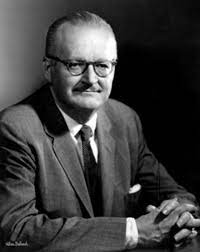Warner, William Lloyd

Bio: (1898-1970) American anthropologist and sociologist. William Lloyd Warner attended his doctoral studies in anthropology at Harvard University, and the basis of his dissertation was field research of Australian Aborigines, which he studied for three years. His first book, A Black Civilization (1937), is the product of that research. Warner taught at Harvard, the University of Chicago, and Michigan State University. During his time at the University of Chicago, Warner became a close associate of Elton Mayo.
Warner is known for applying an anthropological approach to research in American society. Warner wanted to apply the way he studied kinship, marriage, social solidarity, and religious life among Aborigines to the study of small communities in the United States. The first such research was conducted in the late 1930s in a small town in the state of Massachusetts (that city is known by the nickname given to it by Warner - Yankee City), using interviews, surveys, observations, and document collection methods. Warner hypothesized that the role that kinship plays in tribal society, in modern society, is taken over by social stratification because stratification affects economic relations, sense of identity and belonging to a community, value systems, and forms of solidarity. He was primarily interested in status stratification, which determines the level of privilege, specific rights, and duties of members of a certain class and their patterns of living.
The results of the research are presented in the book The Status System of a Modern Community, 2 vols. (1941, 1942). In the city where he conducted his research, Warner identified six specific classes: upper-upper, lower-upper, upper-middle, lower-middle, upper-lower, and lower-lower. The upper-upper class consisted of "patrician aristocrats", the richest families who possessed wealth for generations; they possessed specific patterns of social interaction and behavior, and they lived in the biggest houses and the best part of the city. The lower-upper class was made of families that experienced upward economic mobility and were sometimes richer than some upper-upper class families, but because their wealth was considered "new", those families did not have the same social reputation. In some other cities, where there is greater upward and downward economic mobility, these two classes formed a single class.
The upper-middle class consisted of families who had a small family business, or individuals who were employed as highly-paid professionals. This class formed the basis of political and civic participation in the community. The lower-middle class of owners of small private businesses and highly skilled workers and the upper-lower class, made of skilled workers, made up the majority of the population and had a large dose of inter-class solidarity. The lower class consisted of unskilled workers living in poverty. Warner discovered another type of stratification in the "city of the Yankees", and that was ethnic and racial stratification. Whites and blacks formed two separate "castes," and that caste division intersected class divisions diagonally, and decisively influenced patterns of interaction. Later, Warner studied the patterns of mobility in the United States, the largest companies and their leaders, religion, and educational opportunities.
Main works
A Black Civilization: A Social Study of an Australian Tribe (1937);
Color and Human Nature (1941);
The Status System of a Modern Community, 2 vols. (1941, 1942);
Who Shall Be Educated? The Challenge of Unequal Opportunities (1944);
The Social Systems of American Ethnic Groups (1945);
The Social System of the Modern Factory: The Strike: A Social Analysis (1947);
Democracy in Jonesville: A Study of Quality and Inequality (1949);
Social Class in America: A Manual of Procedure for the Measurement of Social Status (1949);
Structure of American Life (1952);
American Life (1953);
Occupational Mobility in American Business and Industry: 1928-1952 (1955);
Big Business Leaders in America (1955);
The Living and the Dead: A Study of the Symbolic Life of Americans (1959);
Industrial Man: Businessmen and Business Organizations (1959);
The Family of God: A Symbolic Study of Christian Life in America (1961);
The Corporation in the Emergent American Society (1962);
The American Federal Executive: A Study of the Social and Personal Characteristics of the Civil Service (1963);
The Emergent American Society (1967).

